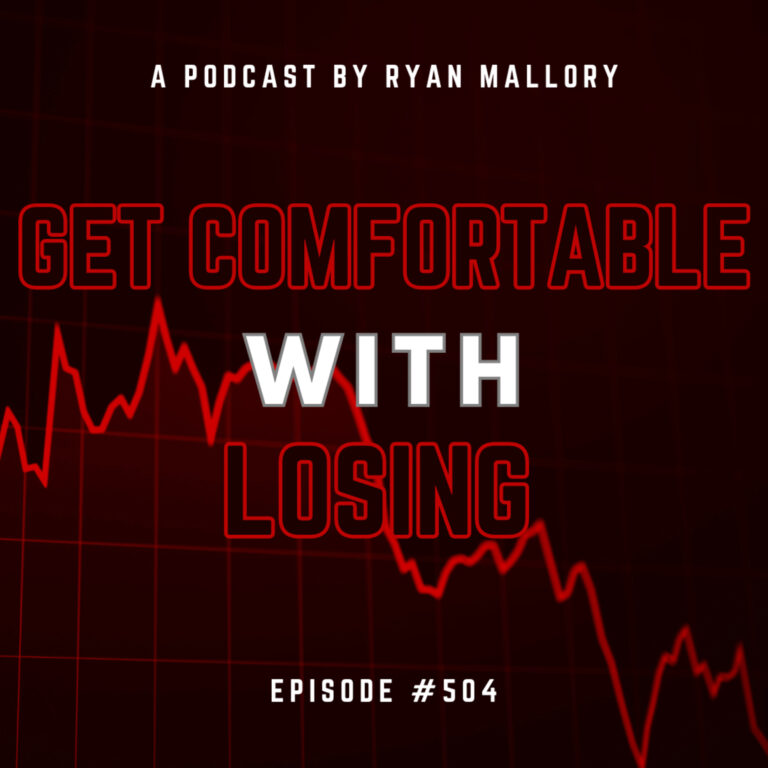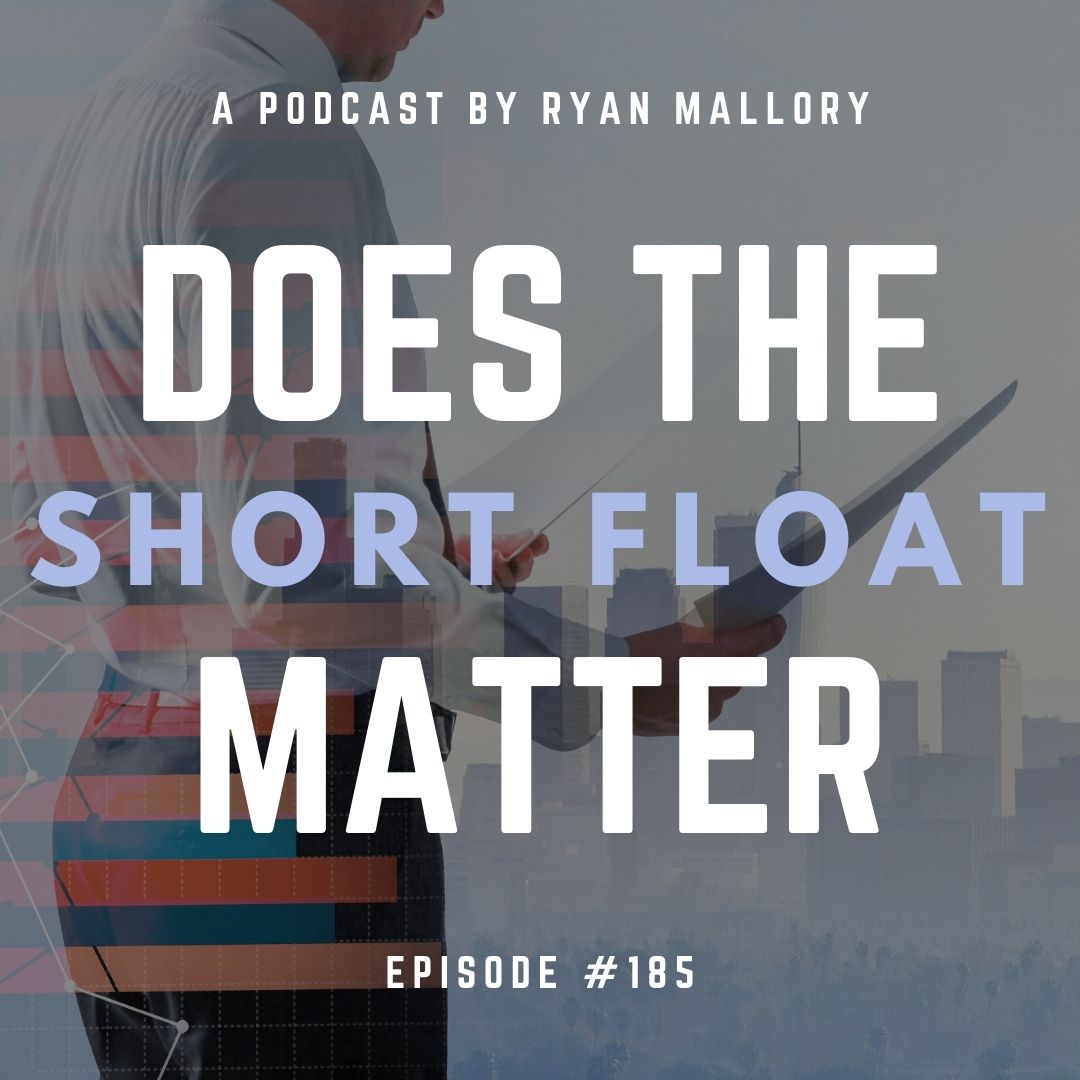Episode Overview
Does the short float percentage matter on trades? Should you get into a stock simply because it has a high short float? In this episode, Ryan digs into whether you should be paying attention to how much a stock is being shorted.
Available on: Apple Podcasts | Spotify | Amazon | YouTube
Episode Highlights & Timestamps
- [0:07] Does Short Float Matter
Ryan begins by focusing on the concept of short float, questioning whether the percentage of shares being shorted has any real impact on swing trading. - [0:45] Herbie‘s Question
A listener asks if monitoring how much of a stock is being shorted should factor into swing trading decisions. - [2:59] Understanding Short Float
Ryan breaks down what short float means, how it is calculated, and why traders pay attention to it. - [5:33] The Short Squeeze Phenomenon
Discussion of Wall Street Bets, AMC, GameStop, and how short squeezes occur when institutions are forced to cover their positions. - [9:47] Why High Short Float Can Be Risky
Ryan emphasizes that high short float stocks are often troubled companies and explains why traders should not rely solely on short interest when making trades.
Key Takeaways from This Episode:
- Short Float Defined: Short float is the percentage of a stock’s tradable shares that are being shorted by traders.
- Short Squeezes Are Rare: While short squeezes can cause huge moves, they are the exception, not the rule.
- Risks of High Short Float: Stocks with high short float often face serious fundamental or financial risks that attract heavy shorting.
- Don’t Trade on Hype Alone: Avoid buying stocks just because they have a high short float. Stick to setups with sound risk and reward.
- Focus on Technicals: Use technical analysis and risk management strategies rather than speculation on short float percentages when swing trading.
Resources & Links Mentioned:
- Swing Trading the Stock Market – Daily market analysis, trade setups, and insights by Ryan Mallory.
- Join the SharePlanner Trading Block – Get real-time trade alerts and community support.

Take the Next Step:
✅ Stay Connected: Subscribe to Ryan’s newsletter to get free access to Ryan’s Swing Trading Resource Library, along with receiving actionable swing trading strategies and risk management tips delivered straight to your inbox.
📈 Level Up Your Trading: Ready for structured training? Enroll in Ryan’s Swing Trading Mastery Course, The Self-Made Trader, and get the complete trading course, from the foundational elements of trading to advanced setups and profitable strategies.
📲 Join the Trading Community: Sign up for SharePlanner’s Trading Block to become part of Ryan’s swing-trading community, which includes all of Ryan’s real-time swing trades and live market analysis.
Full Episode Transcript
Click here to read the full transcript
0:07
Hey, I’m Ryan Mallory, and this is my Swing Trading the Stock Market. I’m here to teach you how to trade in a complex, ever changing world of finance. Learn what it means to trade profitably and consistently, managing risk, avoiding the pitfalls of trading, and most importantly, to let those winners run wild.
0:25
You can succeed at the stock market, and I’m ready to show you how. Hey, everybody, this is Ryan Mallory with Swing Trading the Stock Market, and today’s episodes are gonna be a good one. It’s gonna be about the short float. Does it matter? Does the percentage of shares outstanding that are being shorted, does that matter?
0:45
We’re gonna talk about all of that and more. This email here comes from a guy we’re gonna call him Herbie, like Herbie Hancock from Tommy Boy, when Tommy Boy himself, he was trying to pass a college exam and it asked who one of the founding fathers was, and he says it was Herbie Hancock. That’s who we’re gonna call this guy today, Herbie. Say hi, Ryan. I was wondering if you would be willing to tell me if paying attention to how much a stock is being shorted has much of an effect on swing trading. I’m a horrible question asker, so I hope this makes sense. I have listened to most of your content and have learned a ton.
1:18
I’m just not sure if you have covered this before, so my apologies, and if so, I will go back through it all. Sirily, Herbie. Now, before I answer this question, what am I drinking? I am drinking bird dog, blackberry flavored whiskey, and it’s 40% alcohol, 80 proof. And as you know from past experiences, I’m not a huge fan of these flavored whiskeys or bourbons that try to add some kind of like interesting like fruity or a peanut buttery or chocolatey flavor to it. So I don’t have high hopes for it.
1:51
And when I look at it, it has a Like a golden brown, but like cloudy look to it. It’s not like a very clear whiskey. So the nose, it’s a strong blackberry flavor. And that’s obvious cause they basically touted as being a blackberry whiskey.
2:08
Now, the taste, I don’t know. I don’t, I really don’t like it. I mean, I could taste the blackberry. It’s definitely a strong blackberry taste, but it comes across like a cough syrup, not completely like a cough syrup, but it has that hint of cough syrupness. It’s very syrupy too. So I’m not a, I’m not a big fan of it. I really think this is like a 4.3 whiskey. It’s bad. I mean, I would never buy it. I bought a little taste test of it and that’s the most I’ll get. I’ll go to my grave, never having drink in this one ever again. And I can live with that. It’s just not good. These flavored whiskeys, they just really need to go.
2:40
I mean, I think something like this, maybe you can mix it with something. I don’t even know what you would mix it with. It just doesn’t It doesn’t seem like it would go with anything. And so then if you’re drinking it by itself, that doesn’t taste good. So, 43 at best. It’s not the worst fruity whiskey that I’ve ever had, but it’s not anywhere near uh everyday sipper or anything that you want to keep on the shelf.
2:59
So there you have it. Now, as for the short flow, does it matter? Well, first off, I think it’s important to go back and for those listening and not completely sure about what I’m talking about when I talk about the flow number of shares outstanding, what does all that mean?
3:15
Well, for the float, that’s the shares that are available to the public to buy, to sell, to short. You also have shares that are outstanding and that’s going to include the float, but it’s also going to include shares that are restricted, which also means that the average trader like you and myself can’t have access to.
3:32
So we’re left with the float and that’s what we’re allowed to trade off of. So the short float’s going to be the percentage of shares out of that float that’s short. So to keep the math simple, if you have 100 shares in the float and 10 of them are being shorted, then you have a 10% short float. Now people get really excited.
3:49
When there is a high short flow, because what happens when you short a stock is you’re borrowing the shares from your broker and you’re selling it and then you’re hoping the stock will go down so that you can buy back those shares and return them to the broker from a smaller price and then you get to keep the difference.
4:05
Let’s say for instance, you have a Yeti cup, OK? And those things go for like $30 right? And I say, hey, can I borrow your Yeti cup? And you’re like, yeah, sure, Ryan, and I take it, and I sell it to a friend. For $30. Well, I got $30 for selling your Yeti cup, but I still owe you a Yeti cup.
4:25
So what I hope to do is that the value of the Yeti cup will fall or maybe they’ll go on sale and they’ll be selling them for $15 which we all know those things do not go on sale. But anyways, let’s just pretend that they do. And I’m able to buy that same Yeti cup that I just borrowed from you for $15 and then I return it to you.
4:42
You’re happy you got your Yeti cup back. I sold it another Yei cup for $30 and I get to keep the $15 difference between the two, right? Everybody goes away happy. It’s kind of the same thing. You’re borrowing shares from your broker, you’re selling it, you’re hoping the stock will drop and that you can buy them back at a cheaper price so that you can give them back to your broker and everybody goes away happy and you get to keep the difference between what you sold them for and what you bought them back for.
5:06
So, When everybody sees a high short flow, that means there’s a lot of people in the future that have to ultimately buy back these shares. And if it goes up too high, they’re gonna get a margin call and be forced to buy back those shares. So people see a high short flow, they’re like, let’s start buying the stock because if the stock ever goes up, it’s going to start compounding on each other because everybody that’s short on the stock is going to have to buy back those shares, creating more buying and causing the stock to go even higher.
5:33
Now you go back to this whole Wall Street bets thing that’s been going on. Where they’ve been targeting some of these stocks that a lot of people have been short on for a long time like AMC, like BlackBerry, like GameStock companies that they feel like these are going out of business, they’re worth being short on.
5:48
They have bad fundamentals, all that stuff. Well, comess Wall Street bets, they pride themselves on buying these companies that should. Go up, but they have so much of a following that they can get them to go up. So then they get these big institutions that are short on them to get squeezed.
6:04
That’s what we call a short squeeze. They’re being squeezed into buying the stock, causing it to go even higher, and it usually causes the stock to go absolutely parabolic when you do see a short squeeze unfolding. So Wall Street Bets, they were targeting a lot of these stocks that had short floats of 30 or 40 or 50%, and they were getting a whole bunch of retailers to buy these stocks and to drive the stock price higher and then all of a sudden the shorts were having to cover their position.
6:29
They were getting margin called and it was forcing the stock to go even higher. So then not only the Wall Street bets crowd pushing the stock higher, then you got the. Institutions that are having to cover their shorts, when you cover a short, that means you’re buying it back, you’re closing it that short position out, and that causes it because those people who are short the stock are now becoming buyers and so it just becomes a snowball effect where the retailers, the Wall Street bets crowds buying the stock, they’re forcing the institutions to buy the stock because they gotta close out their positions so they don’t take an infinite loss.
7:00
And it just keeps going higher and higher because remember when you’re short of stock, it’s not like when you buy a stock and you’re hoping that it goes up, right? You can make infinite gains when you buy a stock and hope that it goes higher. But you can only lose what you put into it, meaning that if the stock goes down to 0, you lose everything that you put into it.
7:18
Now, on the short side, you can only make 100% on the trade by going from price that you shorted it at all the way down to 0. But on the flip side, you have an infinite amount of loss that you can take. Let’s say you shorted the stock at $100 and it goes up to $210.
7:35
Well, you just lost 110%. So you can lose more than what you actually shorted that stock for. So these companies, they don’t want to be caught in these massive short squeezes, so they’re forced to cover their positions, which creates these parabolic moves in stocks like GameStop and AMC.
7:52
Now you can find the short flow, like I said earlier, the brokers have to report it twice a month. You could take a look right now at Apple. Apple has 0.6% of their shares short. AMC has 16%, that’s pretty high. You start getting over like 89, 10%, you’re getting into a lot of shares being shorted there.
8:12
You take SQ square. They have 8.1% of their float short and 7% of their total shares outstanding short. And you can get all this stuff. It’s public information. I just pulled it up off of Yahoo Finance.com.
8:28
I don’t care too much about it, honestly. Uh, TC 2000 will let you even chart it out, I think, or at least some platforms will let you chart it out. So all that information’s out there, Yahoo Finance.com, but what’s even better information is if you go to swingtradingthestockmarket.com and sign up for my membership there, you get all my market research each and every day.
8:47
That’s going to. Include my daily list of trade setups that I’m following. Long and short, you’re also going to get the most intriguing charts trade setups that I come across each and every day, plus my weekly master watch list updated at the end of each week along with updates of all the Fang stocks, the S&P 500, the Nasdaq 100, and the Russell 2000.
9:08
So check that out, swingtradingthestockmarket.com and in doing so, you’ll be supporting this podcast and, and the ability for me to continue to provide this great content to you each and every week. So there you have it. You have a good idea of what we’re talking about when it comes to the jargon and the lingo associated with shorting stocks, what the short float means, and everything else.
9:29
So a lot of people, they will do these screens for stocks like give me a list of stocks that have 25% of their shares. Being shorted right now are 50% of their shares being shorted right now and they’re doing that because they wanna find something that has a huge short flow and hopes that they can be part of a big short squeeze.
9:47
Now you gotta remember there’s a lot of really smart people out there that are shorting some stocks and so when you’re going against them, you’re saying that OK, these people who have access to unbelievable amounts of research and people within the company itself, they are wrong. I’m gonna be right. I’m gonna take the opposite.
10:03
Inside of that trade, now all that sounds like a great idea on the surface. Let’s say a person shorting a stock at $100 a share again. I’m gonna try and keep it easy with the from the math standpoint and you’re saying, OK, man, look at this, this guy’s short and they don’t tell you where they’re getting short at in most cases at least, you know, unless they’re making that public as well.
10:21
But, but let’s say the average price that people shorted stock ABC at was $100 a share and 40 or 50% of the flow is short right now. You see that it’s like, oh, I’m gonna buy the stock because I wanna see them get squeezed and I want to make a lot of money off of them. Now, let’s say the stock goes from $100 all the way down to $75.
10:41
Well, they’re up 25%, you’re down 25%, and then all of a sudden you do get the short squeeze. It goes from 75 back up to $95. That’s a big move. However, you’re still losing on the trade, and not all of these short squeezes are gonna go up like what you see with AMC and what you saw with GameStop.
10:58
Those are abnormalities. Those are way beyond the scope of your typical squeeze. So is it relevant to trading? I don’t really care. Because a lot of times when there is a high short flow there’s probably something inherently wrong with the stock that’s causing a lot of people to be that negative on the stock itself and so there’s a good chance that there’s some major headline risk, there’s some major fundamental risk you are exposed to getting an earnings warning because they’re not doing good.
11:24
You risk a possible bankruptcy. There’s a lot that can go wrong when you start going after these companies. Companies that are just going downhill like take a lot of your old school retailers, the ones that you used to find in the malls all the time. They have some high short floats to them right now and a lot of them probably won’t even be around 10 years from now.
11:43
And the reason why they have a high short flow is there’s a lot of people that believe that they’re ultimately not going to make it, so they’re just gonna ride that value of the stock down to 0. Now only comes Wall Street bets they’re like, hey, let’s get the retail crowd in on this stock. And let’s drive it up to God knows how high. Let’s drive it up 10,000% or whatever.
11:59
But you got to remember those events like what you saw with GameStop, what you saw in AMC, those are the exceptions, not the norm. There’s a lot of people out there right now because I get the emails about it, say, hey, I’m in the stock because it has a high short flow, but it’s not getting squeezed off. Well, you’re really just playing a game like you would at a casino in Las Vegas.
12:17
You’re hoping that you’ll get lucky and you’ll score big. So just because it has a high short flow doesn’t ultimately mean that it’s going to be squeezed and I think a lot of people confuse that they say, oh look at this, everybody’s shorting it, it’s gonna get squeezed, not necessarily. You can have a lot of people that are able to get out over time and lower that short percentage.
12:33
So don’t use that as a reason to swing trade in the stock market. If it happens that you, that there’s a major short squeeze, great, but don’t bank on that. If you’re gonna be a technical trader, you need to make sure that there’s a trade set up there that you can use a good risk reward set up on where the reward is at least twice that of the risk.
12:53
So again, to wrap this up, I don’t think that you should be making the percentage of shares short on the float an integral part of why you buy or sell a stock. If you enjoyed this episode, please make sure to leave me a 5 star review. I always appreciate those things.
13:09
Also, make sure to keep sending me your questions. Send me your questions, ryan@shareplanner.com. I do read them all. I want to hear from you guys and I want to be able to put as many of these things on air as possible. Send me those. Thank you guys, and God bless. Thanks for listening to my podcast, Swing Trading the stock market.
13:25
I’d like to encourage you to join me in the SharePlanner trading block where I navigate the stock market each day with traders from around the world. With your membership, you will get a 7 day trial and access to my trading room, including alerts via text, And WhatsApp. So go ahead, sign up by going to shareplanner.com/tradingblock.
13:44
That’s www.shareplanner.com/trading-block, and follow me on SharePlanner’s Twitter, Instagram, and Facebook where I provide unique market and trading information every day. If you have any questions, please feel free to email me at ryan@shareplanner.com.
14:00
All the best to you and I look forward to trading with you soon.
Enjoy this episode? Please leave a 5-star review and share your feedback! It helps others find the podcast and enables Ryan to produce more content that benefits the trading community.
Have a question or story to share? Email Ryan and your experience could be featured in an upcoming episode!
Become part of the Trading Block and get my trades, and learn how I manage them for consistent profits. With your subscription you will get my real-time trade setups via Discord and email, as well as become part of an incredibly helpful and knowledgeable community of traders to grow and learn with. If you’re not sure it is for you, don’t worry, because you get a Free 7-Day Trial. So Sign Up Today!

Welcome to Swing Trading the Stock Market Podcast!
I want you to become a better trader, and you know what? You absolutely can!
Commit these three rules to memory and to your trading:
#1: Manage the RISK ALWAYS!
#2: Keep the Losses Small
#3: Do #1 & #2 and the profits will take care of themselves.
That’s right, successful swing-trading is about managing the risk, and with Swing Trading the Stock Market podcast, I encourage you to email me (ryan@shareplanner.com) your questions, and there’s a good chance I’ll make a future podcast out of your stock market related question.
As swing traders, we have to accept that losing will be a regular part of trading and one that we must accept. In this podcast episode, Ryan explains how a trader who isn't comfortable with losing is a losing trader. If you're not comfortable with losing in the stock market, you'll never find real success as a trader either.
Be sure to check out my Swing-Trading offering through SharePlanner that goes hand-in-hand with my podcast, offering all of the research, charts and technical analysis on the stock market and individual stocks, not to mention my personal watch-lists, reviews and regular updates on the most popular stocks, including the all-important big tech stocks. Check it out now at: https://www.shareplanner.com/premium-plans
📈 START SWING-TRADING WITH ME! 📈
Click here to subscribe: https://shareplanner.com/tradingblock
— — — — — — — — —
💻 STOCK MARKET TRAINING COURSES 💻
Click here for all of my training courses: https://www.shareplanner.com/trading-academy
– The A-Z of the Self-Made Trader –https://www.shareplanner.com/the-a-z-of-the-self-made-trader
– The Winning Watch-List — https://www.shareplanner.com/winning-watchlist
– Patterns to Profits — https://www.shareplanner.com/patterns-to-profits
– Get 1-on-1 Coaching — https://www.shareplanner.com/coaching
— — — — — — — — —
❤️ SUBSCRIBE TO MY YOUTUBE CHANNEL 📺
Click here to subscribe: https://www.youtube.com/shareplanner?sub_confirmation=1
🎧 LISTEN TO MY PODCAST 🎵
Click here to listen to my podcast: https://open.spotify.com/show/5Nn7MhTB9HJSyQ0C6bMKXI
— — — — — — — — —
💰 FREE RESOURCES 💰
— — — — — — — — —
🛠 TOOLS OF THE TRADE 🛠
Software I use (TC2000): https://bit.ly/2HBdnBm
— — — — — — — — —
📱 FOLLOW SHAREPLANNER ON SOCIAL MEDIA 📱
*Disclaimer: Ryan Mallory is not a financial adviser and this podcast is for entertainment purposes only. Consult your financial adviser before making any decisions.





